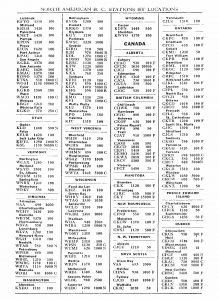
“Radex” (‘Radio Index’) magazine Summer 1936 station listings for Wash. & BC. Network affiliation (if any) is noted at the far right of the columns. I have a number of these in my collection.

“Radex” (‘Radio Index’) magazine Summer 1936 station listings for Wash. & BC. Network affiliation (if any) is noted at the far right of the columns. I have a number of these in my collection.
Some comments may be held for moderation. (New users)
This site uses Akismet to reduce spam. Learn how your comment data is processed.
Copyright © 2024 QZVX - Broadcast History & Current Affairs

From the Internet Archive (www.archive.org) we reclaim some of our Lost Comments:
Steven Smith says:
August 2, 2018 4:01 pm at
When I see charts like this I am astounded by how little power most of the stations were operating with…..many eventually prominent stations wit 50 or 100 watts. I guess there was way less industrial interference back then.
mikec says:
August 2, 2018 4:25 pm at
quite right, Steven. In fact, there were very few daytimers back in 1936 as the AM frequencies hadn’t been packed yet – that would occur starting after WW II. There were, however, “share-timers” on some frequencies. Note a number of these in Vancouver BC. Some of these low powered signals carried incredible distances. KXA 770 with it’s incredible salt-water grounding system on the downtown Seattle waterfront was heard many times overseas in the 1940’s by US personnel stationed throughout the Pacific during it’s overnight 4-hour broadcasts. This using 500 watts!!
pugetsound says:
August 4, 2018 10:34 am at
Seattle-Tacoma had 10 radio stations. I will bet you that each one of them ran Christian programming on Sunday, some also on weekdays, regardless of their regular format.
mikec says:
August 4, 2018 2:54 pm at
no doubt Jason. Broadcasting live church services Sunday morning as a freebie was often done in lieu of the FCC minimum airing of local public affairs requirement. The religious shows that were a part of the weekday ‘block programming’ were probably paid syndicated shows as is the case today.